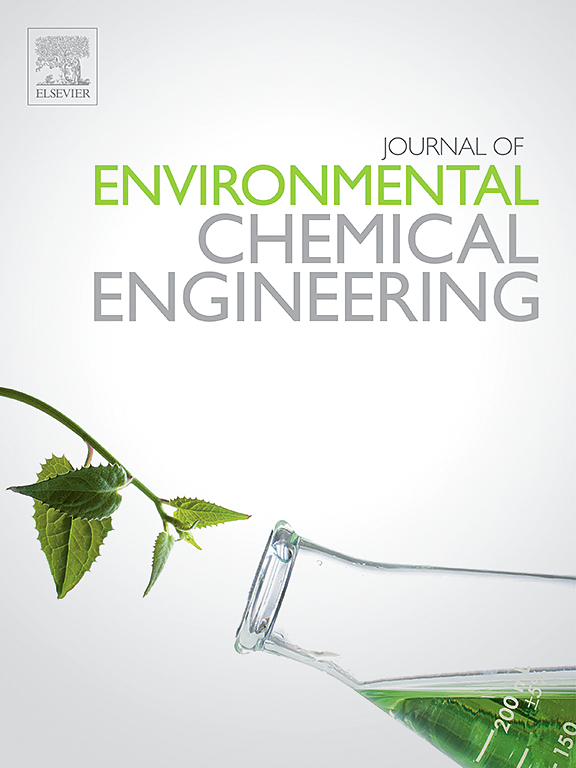利用 MIL-88A(Fe)/BiOI 异质结复合材料的可见光辅助过氧化单硫酸盐活化技术驱动电荷传输以消除酸性红 18
IF 7.4
2区 工程技术
Q1 ENGINEERING, CHEMICAL
引用次数: 0
摘要
通过可见光辅助过硫酸盐活化消除 AR18(酸性红 18)的套内化学沉积法,制备了一种新型棒状 MIL-88A(Fe)/BiOI 异质结复合材料。根据 MIL-88A(Fe)与 BiOI 的质量比,得到了一系列 x%MIL-88A(Fe)/BiOI 复合材料。其中,30%MIL-88A(Fe)/BiOI 可在 40 分钟内去除 97.79% 的 AR18。研究了该工艺的反应参数,如 PMS 浓度、催化剂用量、初始 pH 值和染料浓度。最佳条件为[催化剂]=1 g-L-1,[PMS]=1 mM,pH=7.02。清除实验和 EPR 分析表明,1O2 是 AR18 降解的主要活性物种。根据带状结构、活性物种、XPS、PL、EIS 和光电流响应,证明了复合催化剂在 500 W(λ > 420 nm)氙灯照射下的 Z 型电子传递路径。最后,通过三次循环测试和无机阴离子实验评估了复合催化剂在实际应用中的稳定性和通用性。这项工作为合成高效稳定的基于 MOF 的异质结光催化剂提供了宝贵的指导。本文章由计算机程序翻译,如有差异,请以英文原文为准。
Visible-light-assisted peroxymonosulfate activation using MIL-88A(Fe)/BiOI heterojunction composite to drive charge transport for eliminating acid red 18
A novel rod-shaped MIL-88A(Fe)/BiOI heterojunction composite is fabricated by an in-suit chemical deposition method for visible-light-assisted peroxymonosulfate activation to eliminate AR18 (acid red 18). A series of x%MIL-88A(Fe)/BiOI are obtained according to the mass ratio of MIL-88A(Fe) to BiOI. Among them, 30 %MIL-88A(Fe)/BiOI could remove 97.79 % AR18 within 40 minutes. The reaction parameters on this process are investigated, such as PMS concentration, catalyst dosage, initial pH and dye concentration. The optimal conditions are determined to be [catalyst]= 1 g·L−1, [PMS]=1 mM, pH=7.02. The scavenging experiments and EPR analysis manifest that 1O2 is the main active species for AR18 degradation. In accordance with the band structure, active species, XPS, PL, EIS and photocurrent response, the Z-scheme electron transfer path of the composite catalyst is proved under 500 W (λ > 420 nm) Xenon lamp irradiation. In the end, the stability and universality of the composite catalyst in practical application are evaluated by three cyclic tests and inorganic anion experiments. This work provides valuable guidance for synthesizing efficient and stable MOF based heterojunction photocatalysts.
求助全文
通过发布文献求助,成功后即可免费获取论文全文。
去求助
来源期刊

Journal of Environmental Chemical Engineering
Environmental Science-Pollution
CiteScore
11.40
自引率
6.50%
发文量
2017
审稿时长
27 days
期刊介绍:
The Journal of Environmental Chemical Engineering (JECE) serves as a platform for the dissemination of original and innovative research focusing on the advancement of environmentally-friendly, sustainable technologies. JECE emphasizes the transition towards a carbon-neutral circular economy and a self-sufficient bio-based economy. Topics covered include soil, water, wastewater, and air decontamination; pollution monitoring, prevention, and control; advanced analytics, sensors, impact and risk assessment methodologies in environmental chemical engineering; resource recovery (water, nutrients, materials, energy); industrial ecology; valorization of waste streams; waste management (including e-waste); climate-water-energy-food nexus; novel materials for environmental, chemical, and energy applications; sustainability and environmental safety; water digitalization, water data science, and machine learning; process integration and intensification; recent developments in green chemistry for synthesis, catalysis, and energy; and original research on contaminants of emerging concern, persistent chemicals, and priority substances, including microplastics, nanoplastics, nanomaterials, micropollutants, antimicrobial resistance genes, and emerging pathogens (viruses, bacteria, parasites) of environmental significance.
 求助内容:
求助内容: 应助结果提醒方式:
应助结果提醒方式:


